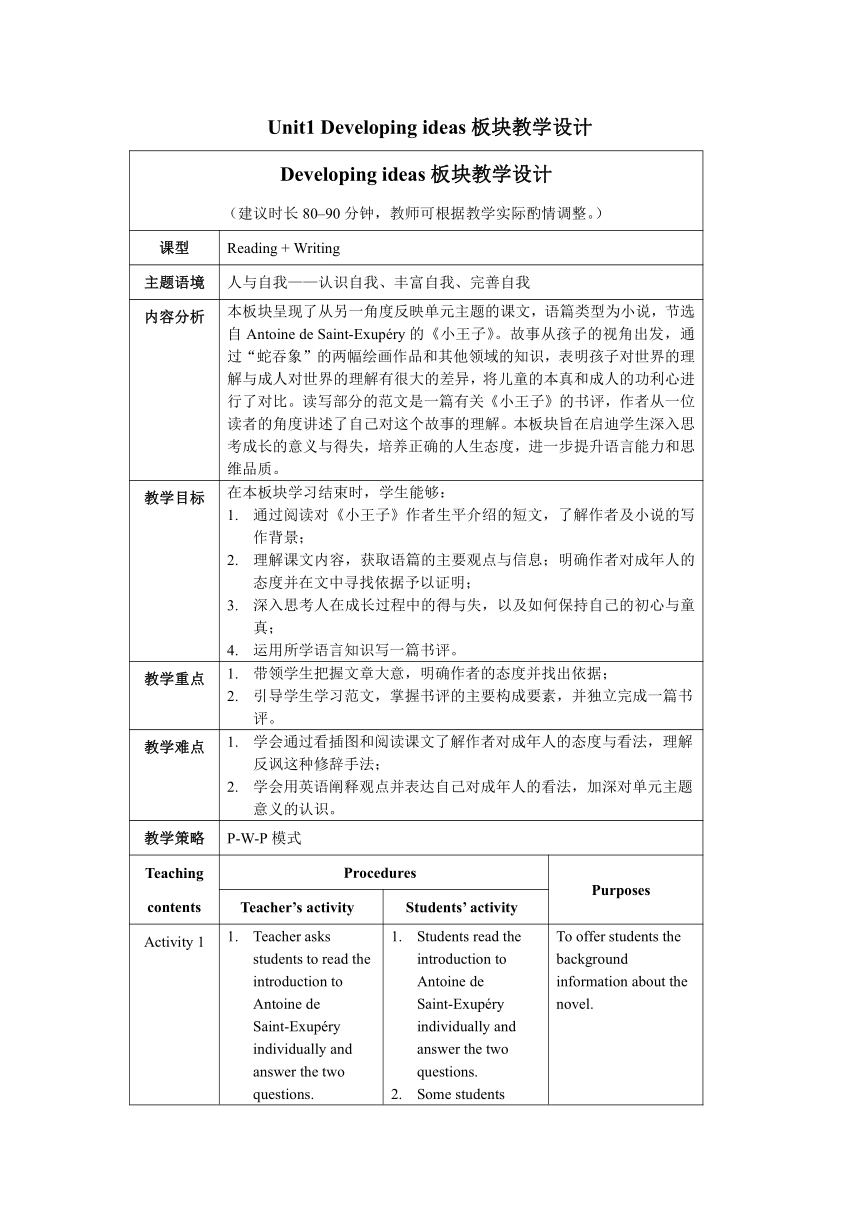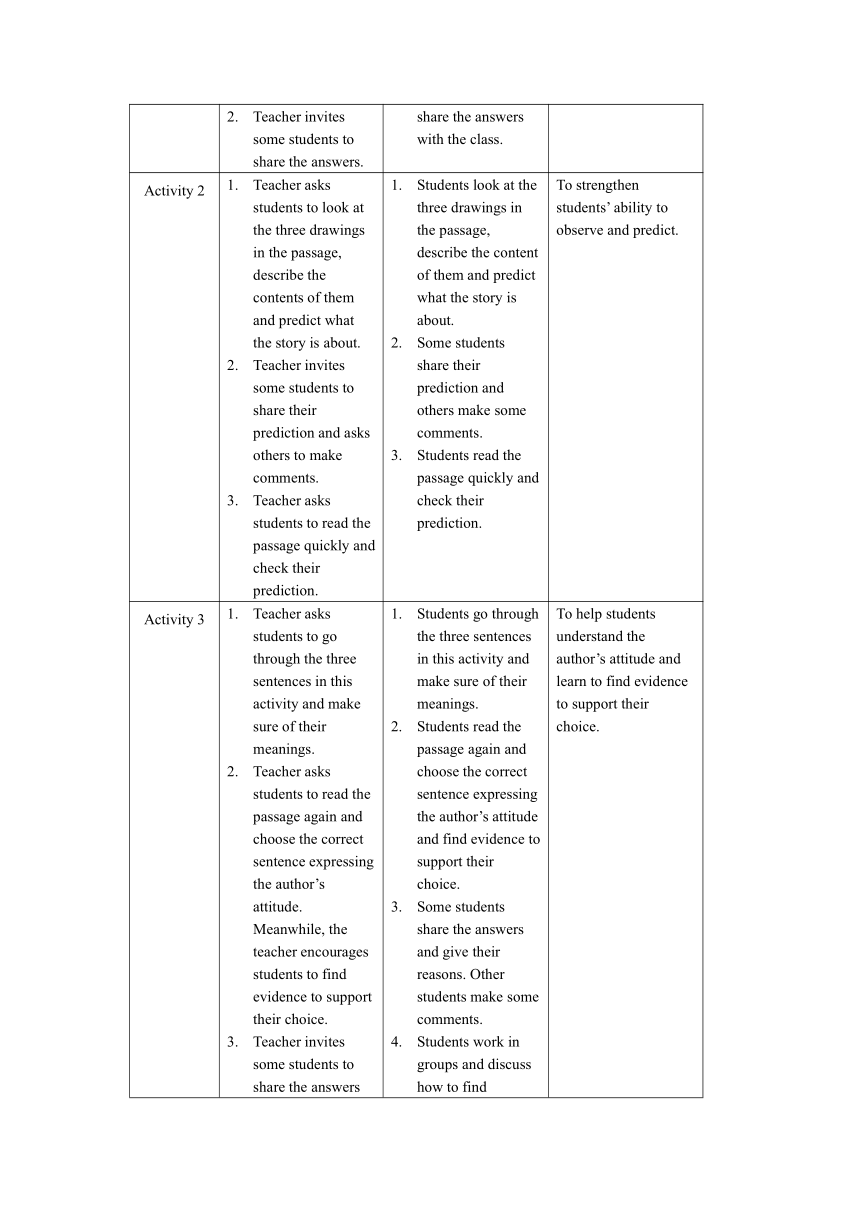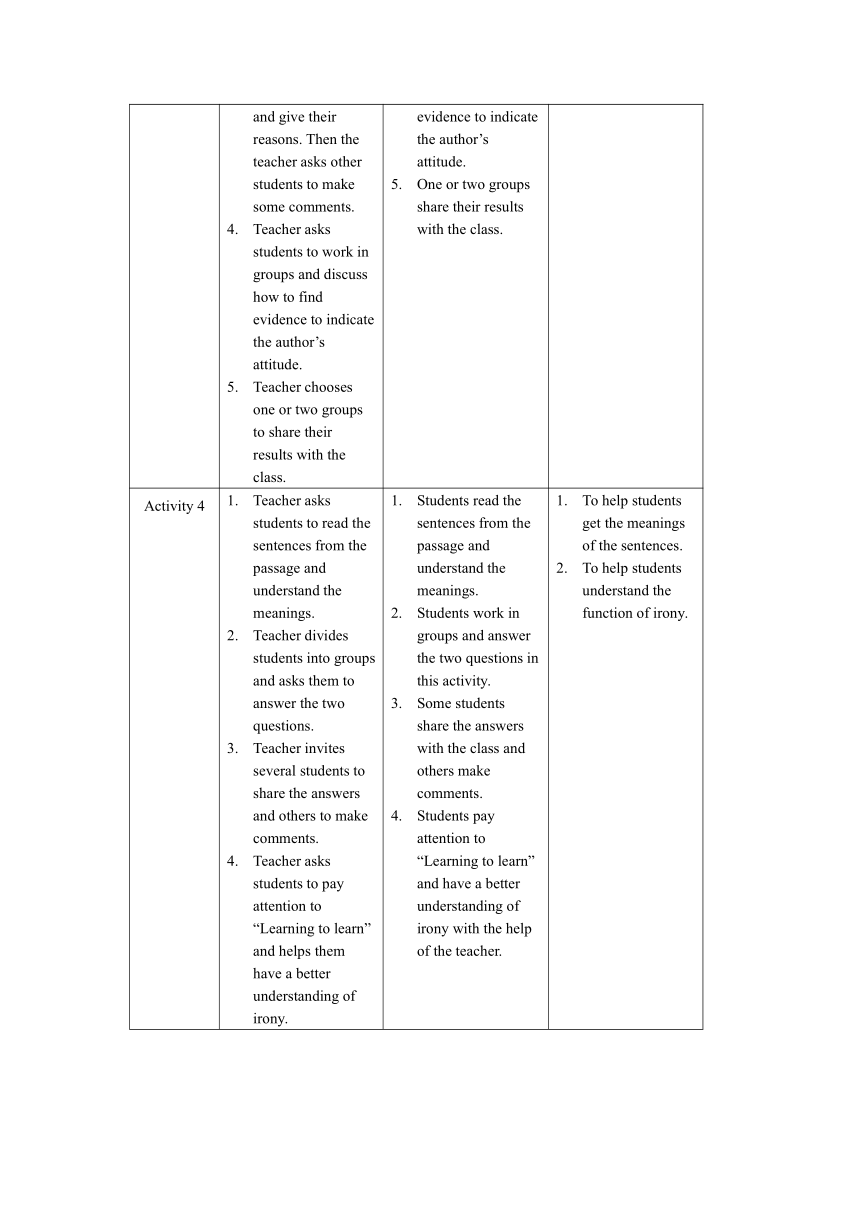外研版(2019)高中英语选择性必修第二册 Unit1 Growing up Developing ideas 板块教学设计
文档属性
| 名称 | 外研版(2019)高中英语选择性必修第二册 Unit1 Growing up Developing ideas 板块教学设计 |

|
|
| 格式 | docx | ||
| 文件大小 | 20.6KB | ||
| 资源类型 | 教案 | ||
| 版本资源 | 外研版(2019) | ||
| 科目 | 英语 | ||
| 更新时间 | 2023-03-03 19:01:05 | ||
图片预览



文档简介
Unit1 Developing ideas板块教学设计
Developing ideas板块教学设计 (建议时长80–90分钟,教师可根据教学实际酌情调整。)
课型 Reading + Writing
主题语境 人与自我——认识自我、丰富自我、完善自我
内容分析 本板块呈现了从另一角度反映单元主题的课文,语篇类型为小说,节选自Antoine de Saint-Exupéry的《小王子》。故事从孩子的视角出发,通过“蛇吞象”的两幅绘画作品和其他领域的知识,表明孩子对世界的理解与成人对世界的理解有很大的差异,将儿童的本真和成人的功利心进行了对比。读写部分的范文是一篇有关《小王子》的书评,作者从一位读者的角度讲述了自己对这个故事的理解。本板块旨在启迪学生深入思考成长的意义与得失,培养正确的人生态度,进一步提升语言能力和思维品质。
教学目标 在本板块学习结束时,学生能够: 通过阅读对《小王子》作者生平介绍的短文,了解作者及小说的写作背景; 理解课文内容,获取语篇的主要观点与信息;明确作者对成年人的态度并在文中寻找依据予以证明; 深入思考人在成长过程中的得与失,以及如何保持自己的初心与童真; 运用所学语言知识写一篇书评。
教学重点 带领学生把握文章大意,明确作者的态度并找出依据; 引导学生学习范文,掌握书评的主要构成要素,并独立完成一篇书评。
教学难点 学会通过看插图和阅读课文了解作者对成年人的态度与看法,理解反讽这种修辞手法; 学会用英语阐释观点并表达自己对成年人的看法,加深对单元主题意义的认识。
教学策略 P-W-P模式
Teaching contents Procedures Purposes
Teacher’s activity Students’ activity
Activity 1 Teacher asks students to read the introduction to Antoine de Saint-Exupéry individually and answer the two questions. Teacher invites some students to share the answers. Students read the introduction to Antoine de Saint-Exupéry individually and answer the two questions. Some students share the answers with the class. To offer students the background information about the novel.
Activity 2 Teacher asks students to look at the three drawings in the passage, describe the contents of them and predict what the story is about. Teacher invites some students to share their prediction and asks others to make comments. Teacher asks students to read the passage quickly and check their prediction. Students look at the three drawings in the passage, describe the content of them and predict what the story is about. Some students share their prediction and others make some comments. Students read the passage quickly and check their prediction. To strengthen students’ ability to observe and predict.
Activity 3 Teacher asks students to go through the three sentences in this activity and make sure of their meanings. Teacher asks students to read the passage again and choose the correct sentence expressing the author’s attitude. Meanwhile, the teacher encourages students to find evidence to support their choice. Teacher invites some students to share the answers and give their reasons. Then the teacher asks other students to make some comments. Teacher asks students to work in groups and discuss how to find evidence to indicate the author’s attitude. Teacher chooses one or two groups to share their results with the class. Students go through the three sentences in this activity and make sure of their meanings. Students read the passage again and choose the correct sentence expressing the author’s attitude and find evidence to support their choice. Some students share the answers and give their reasons. Other students make some comments. Students work in groups and discuss how to find evidence to indicate the author’s attitude. One or two groups share their results with the class. To help students understand the author’s attitude and learn to find evidence to support their choice.
Activity 4 Teacher asks students to read the sentences from the passage and understand the meanings. Teacher divides students into groups and asks them to answer the two questions. Teacher invites several students to share the answers and others to make comments. Teacher asks students to pay attention to “Learning to learn” and helps them have a better understanding of irony. Students read the sentences from the passage and understand the meanings. Students work in groups and answer the two questions in this activity. Some students share the answers with the class and others make comments. Students pay attention to “Learning to learn” and have a better understanding of irony with the help of the teacher. To help students get the meanings of the sentences. To help students understand the function of irony.
Activity 5 Teacher divides students into groups and asks them to discuss whether they agree with the author’s attitude towards grown-ups and give the reasons. Teacher invites some students to share their opinions. Teacher asks students to think of some examples to support their opinions, make notes and then exchange their views in groups. Teacher asks students to prepare for the talk. Teacher invites several students to give their talk to the class and others to make comments. Teacher asks students to think about their performance during the group discussion and how well they actively participate and contribute ideas. Students work in groups and discuss whether they agree with the author’s attitude towards grown-ups and give the reasons. Some students share their opinions with the class. Students think of some examples to support their opinions, make notes and then exchange their views in groups. Students prepare for the talk. Several students give their talk to the class and others make comments. Students think about their performance during the group discussion and how well they actively participate and contribute ideas. To make students learn how to give a talk and express their attitude towards grown-ups and growth.
Think and Share Teacher asks students to think about the questions and discuss them in groups. Teacher invites some students to give answers. Students think about the questions and discuss them in groups. Some students give answers. To enhance students’ understanding of growing up. To encourage students to show their own opinions.
Activity 6 Teacher asks students to read the book review and find the information about the five elements listed on the right side of this page. Teacher invites some students to share the answers. Students read the book review and find the information about the five elements listed on the right side of this page. Some students share the answers with the class. To help students get the basic information of the novel.
Activity 7 Teacher asks students to read the book review again and think about the three questions. Teacher divides students into groups. Then the teacher asks them to discuss the three questions and find the answers. Teacher invites some students on behalf of their groups to give the answers and other students to make comments. Students read the book review again and think about the three questions. Students work in groups, discuss the three questions and find the answers. Some students on behalf of their groups give the answers and others make comments. To help students get the main plot of the novel. To help students learn the key elements included in a book review.
Activity 8 Teacher asks students to work in groups and talk about one book that means a lot to them. Teacher asks students to plan a review of the book and make notes. Teacher asks students to share the notes or content with their partners and make some adjustments. Teacher asks students to finish the book review individually. Students work in pairs and talk about one book that means a lot to them. Students plan a review of the book and make notes. Students share the notes or content with their partners and make some adjustments. Students finish the book review individually. To help students make a preparation for a book review.
Activity 9 Teacher divides students into pairs and asks them to make improvements to each other’s book reviews. Teacher invites some pairs to share their book reviews and others to make comments. Teacher makes proper evaluation. Students work in pairs and make improvements to each other’s book reviews. Some pairs share their book reviews with the whole class and others make comments. Students listen to the teacher’s evaluation. To instruct students how to cooperate with others. To encourage students to learn from their partners.
Developing ideas板块教学设计 (建议时长80–90分钟,教师可根据教学实际酌情调整。)
课型 Reading + Writing
主题语境 人与自我——认识自我、丰富自我、完善自我
内容分析 本板块呈现了从另一角度反映单元主题的课文,语篇类型为小说,节选自Antoine de Saint-Exupéry的《小王子》。故事从孩子的视角出发,通过“蛇吞象”的两幅绘画作品和其他领域的知识,表明孩子对世界的理解与成人对世界的理解有很大的差异,将儿童的本真和成人的功利心进行了对比。读写部分的范文是一篇有关《小王子》的书评,作者从一位读者的角度讲述了自己对这个故事的理解。本板块旨在启迪学生深入思考成长的意义与得失,培养正确的人生态度,进一步提升语言能力和思维品质。
教学目标 在本板块学习结束时,学生能够: 通过阅读对《小王子》作者生平介绍的短文,了解作者及小说的写作背景; 理解课文内容,获取语篇的主要观点与信息;明确作者对成年人的态度并在文中寻找依据予以证明; 深入思考人在成长过程中的得与失,以及如何保持自己的初心与童真; 运用所学语言知识写一篇书评。
教学重点 带领学生把握文章大意,明确作者的态度并找出依据; 引导学生学习范文,掌握书评的主要构成要素,并独立完成一篇书评。
教学难点 学会通过看插图和阅读课文了解作者对成年人的态度与看法,理解反讽这种修辞手法; 学会用英语阐释观点并表达自己对成年人的看法,加深对单元主题意义的认识。
教学策略 P-W-P模式
Teaching contents Procedures Purposes
Teacher’s activity Students’ activity
Activity 1 Teacher asks students to read the introduction to Antoine de Saint-Exupéry individually and answer the two questions. Teacher invites some students to share the answers. Students read the introduction to Antoine de Saint-Exupéry individually and answer the two questions. Some students share the answers with the class. To offer students the background information about the novel.
Activity 2 Teacher asks students to look at the three drawings in the passage, describe the contents of them and predict what the story is about. Teacher invites some students to share their prediction and asks others to make comments. Teacher asks students to read the passage quickly and check their prediction. Students look at the three drawings in the passage, describe the content of them and predict what the story is about. Some students share their prediction and others make some comments. Students read the passage quickly and check their prediction. To strengthen students’ ability to observe and predict.
Activity 3 Teacher asks students to go through the three sentences in this activity and make sure of their meanings. Teacher asks students to read the passage again and choose the correct sentence expressing the author’s attitude. Meanwhile, the teacher encourages students to find evidence to support their choice. Teacher invites some students to share the answers and give their reasons. Then the teacher asks other students to make some comments. Teacher asks students to work in groups and discuss how to find evidence to indicate the author’s attitude. Teacher chooses one or two groups to share their results with the class. Students go through the three sentences in this activity and make sure of their meanings. Students read the passage again and choose the correct sentence expressing the author’s attitude and find evidence to support their choice. Some students share the answers and give their reasons. Other students make some comments. Students work in groups and discuss how to find evidence to indicate the author’s attitude. One or two groups share their results with the class. To help students understand the author’s attitude and learn to find evidence to support their choice.
Activity 4 Teacher asks students to read the sentences from the passage and understand the meanings. Teacher divides students into groups and asks them to answer the two questions. Teacher invites several students to share the answers and others to make comments. Teacher asks students to pay attention to “Learning to learn” and helps them have a better understanding of irony. Students read the sentences from the passage and understand the meanings. Students work in groups and answer the two questions in this activity. Some students share the answers with the class and others make comments. Students pay attention to “Learning to learn” and have a better understanding of irony with the help of the teacher. To help students get the meanings of the sentences. To help students understand the function of irony.
Activity 5 Teacher divides students into groups and asks them to discuss whether they agree with the author’s attitude towards grown-ups and give the reasons. Teacher invites some students to share their opinions. Teacher asks students to think of some examples to support their opinions, make notes and then exchange their views in groups. Teacher asks students to prepare for the talk. Teacher invites several students to give their talk to the class and others to make comments. Teacher asks students to think about their performance during the group discussion and how well they actively participate and contribute ideas. Students work in groups and discuss whether they agree with the author’s attitude towards grown-ups and give the reasons. Some students share their opinions with the class. Students think of some examples to support their opinions, make notes and then exchange their views in groups. Students prepare for the talk. Several students give their talk to the class and others make comments. Students think about their performance during the group discussion and how well they actively participate and contribute ideas. To make students learn how to give a talk and express their attitude towards grown-ups and growth.
Think and Share Teacher asks students to think about the questions and discuss them in groups. Teacher invites some students to give answers. Students think about the questions and discuss them in groups. Some students give answers. To enhance students’ understanding of growing up. To encourage students to show their own opinions.
Activity 6 Teacher asks students to read the book review and find the information about the five elements listed on the right side of this page. Teacher invites some students to share the answers. Students read the book review and find the information about the five elements listed on the right side of this page. Some students share the answers with the class. To help students get the basic information of the novel.
Activity 7 Teacher asks students to read the book review again and think about the three questions. Teacher divides students into groups. Then the teacher asks them to discuss the three questions and find the answers. Teacher invites some students on behalf of their groups to give the answers and other students to make comments. Students read the book review again and think about the three questions. Students work in groups, discuss the three questions and find the answers. Some students on behalf of their groups give the answers and others make comments. To help students get the main plot of the novel. To help students learn the key elements included in a book review.
Activity 8 Teacher asks students to work in groups and talk about one book that means a lot to them. Teacher asks students to plan a review of the book and make notes. Teacher asks students to share the notes or content with their partners and make some adjustments. Teacher asks students to finish the book review individually. Students work in pairs and talk about one book that means a lot to them. Students plan a review of the book and make notes. Students share the notes or content with their partners and make some adjustments. Students finish the book review individually. To help students make a preparation for a book review.
Activity 9 Teacher divides students into pairs and asks them to make improvements to each other’s book reviews. Teacher invites some pairs to share their book reviews and others to make comments. Teacher makes proper evaluation. Students work in pairs and make improvements to each other’s book reviews. Some pairs share their book reviews with the whole class and others make comments. Students listen to the teacher’s evaluation. To instruct students how to cooperate with others. To encourage students to learn from their partners.
